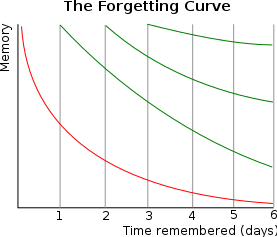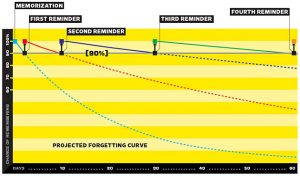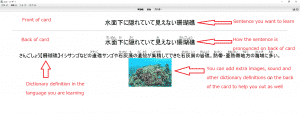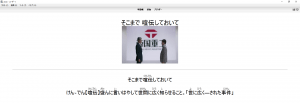Learning Vocabulary Words Fast and Effectively
Let’s face it, the core of language learning is vocabulary.
The more vocabulary you know, the more of the language you can understand and the more articulate you can make yourself sound in speech and writing.
Vocabulary is incredibly important and learning it quickly is something that can super boost your language skills.
However, in this day and age the internet is saturated with different techniques that aren’t all properly tested or backed up with a bit of science and common knowledge.
A lot of what you can find on the internet, or even in schools for that matter, is just incredibly inefficient.
But today that all changes for you, for I will now introduce to you the one concept that will change the way you study for the rest of your life.
Learning Things Efficiently With Spaced Repetition
When it comes to learning anything quickly, we are going to want to use spaced repetition.
When we learn new vocabulary we are going to want to make sure that we do the following:
- Optimize our revision time of vocabulary
- Reduce the amount of vocabulary that we forget
- Reduce studying time in order to learn even more vocabulary
Spaced Repetition allows us to do all of these.
Essentially spaced repetition systems/software use an algorithm that determines the optimal point for you to review a piece of information by using your feedback on how difficult a card was for you.
There are a variety of different software and apps that include spaced repetition in them in order to make your studying more efficient.
In this post I am going to recommend that you use a piece of software called “Anki“.
Anki is a free flashcard program (for windows, mac and android but you have to pay for the app on the iTunes).
You can make an account and use Anki across all your devices by syncing your data.
There’s even a browser version if you really need to do some study but don’t have access to the apps or software on a particular device.
I recommend Anki because it has a lot of room for customization yet it’s also very easy to use without too much prior knowledge.
Anki does just look like a simple flashcard app but it has support for various different content and it also has a large community so if you ever have an issue with the software then you can always find someone who can help online.
It really is one of the most versatile apps that use spaced repetition and I know people who use it for math, medicine, people, place names, language learning, as well as many other topics.
It can be used to memorize anything.
Spaced repetition is also insanely efficient.
With a traditional study routine, one would have to go through all their vocabulary that they have learnt every single day in order to remember it.
With spaced repetition, instead of spending everyday going through the same set of flashcards, you can spread out your reviews and revise information just before you forget it in order to optimize your study routine.
Doing this has two benefits.
- Reviewing information just before you forget it makes it stick in memory longer
- Doing this optimizes your study routine so that you don’t have to keep reviewing the same information everyday
You can do this yourself with paper flashcards and try to organize everything into separate boxes, however it’s not as efficient as Anki and other software that implement spaced repetition.
Anki, for example, will make an educated guess, based on your answer to the flashcard, as to when you are going to forget a card.
As you learn stuff this means that you won’t see things that are in your long-term memory very often yet you will see information that you have just learnt, or that you’ve forgotten, more often.
When learning a new piece of information, you need to see it more often than when it’s in your long-term memory.
Anki schedules your cards for you so you don’t have to worry about this.
So as time passes, you won’t have to review a card that often.
What this means is that you can keep vocabulary that you have already learnt in your long-term memory while also learning new vocabulary as well.
Learning vocabulary quickly is obviously meaningless if you are going to forget it so this is a huge for us.
To get a better understanding let’s take a look at the standard forgetting curve and a forgetting curve using spaced repetition:

This normal forgetting curve shows us that after learning a new piece of information we are likely to have forgotten 50% of it after 1 day and it gets even worse until you reach day 6 and have completely forgotten the information.
If you based your study routine on this curve then you are going to need to study everything everyday in order to not forget the information.
However, this is overload and you will waste a lot of time in doing this.
But if you take a look at this spaced repetition graph you will notice that the days when you get reminded are spread out further, yet your retention rate is kept above 90%.
 If you want to know a bit more about the SRS then this article is a good start: Want to Remember Everything You’ll Ever Learn? Surrender to This Algorithm.
If you want to know a bit more about the SRS then this article is a good start: Want to Remember Everything You’ll Ever Learn? Surrender to This Algorithm.
This is essentially what Anki does.
It automatically spaces out our revision in order to optimize our study.
This in turn gives us more free time which we can use to learn more new words.
In general, if used correctly, Anki will guarantee a 90%+ retention rate.
That’s a pretty freaking good percentage.
In order to get this high level of retention though you have to go about creating your flashcards in the right manner, otherwise your brain isn’t going to work with you and you won’t learn new words in the first place let alone be able to remember them.
So what can you do to learn vocabulary efficiently?
Learn Words via Examples Sentences with Sentence Mining
Right, so Anki by itself is already going to dramatically increase the rate at which you can learn new vocabulary no matter what specific way you go about it, however, in order to really learn vocab and fully understand it, we are going to need to use a method known as sentence mining.
Sentence mining pretty much is exactly what it sounds like.
The process of sentence mining is fairly simple.
The idea is that when you spend time listening/reading Japanese you will eventually come across sentences that you almost completely understand but there’s say one word or a piece of grammar that you don’t know or aren’t sure about.
If you come across one of these sentences and feel like you want to learn the sentence then from here you can add it in to your SRS flashcard program.
Why Sentence Mining?
With sentence mining we learn new words and grammar in the context of sentences.
A lot of people tend to take long vocabulary lists and they attempt to memorize every word on the list.
Assuming you manage to rote memorize an entire vocabulary list, will you actually know how to use these words in a sentence?
Of course not!
The language you are learning is completely different to English, even if it’s a close language like French, it’s still completely different and has its own quirks that you cannot possibly know about by simply memorizing a vocab sheet.
Learning a language via example sentences is far better than learning individual words or grammar rules.
This is because correct example sentences are quite simply a collection of words and grammar rules with the plus of showing you the nuance in which each component is used in.
This is incredibly important.
There is absolutely no point in learning single words or grammar when you have no idea as to how to use it in sentence.
There are plenty of words in Japanese that are incredibly similar in meaning, and may even translate to the same word in English, but they will have slight different nuances and usages.
This is crucial as it can mean the difference between sounding really amazing at Japanese and sounding a little bit off.
Here are some examples in English:
“I picked up a apple.” – Incorrect
“I picked up an apple.” – Correct
“These computer program.” – Incorrect
“This computer program.” – Correct
As you can see, in both sentences the meaning comes across perfectly fine for those that are incorrect but it just doesn’t feel right.
Sentence mining fixes this and given enough sentences you will get the joist of the majority of the language you are trying to learn and will know when to, and when not to, use the right words and grammar without thinking about it.
Without seeing the context of which a word or grammar is used in, you have no real hope of being able to fully understand it’s nuance in Japanese.
Sentence mining helps you to get one of the possible nuances/meanings of a word into your head which you can then build upon in other sentences or by reading and listening to Japanese.
Essentially sentence mining helps you to internalize the language you are trying to learn as well as to better understand it and it allows you to notice new parts of the language.
This is done with the help of the SRS as you will see each flashcard constantly over time so that you never forget it.
It gives you a boost, and combined with an SRS, can allow you to learn thousands of new vocabulary easily without ever forgetting them.
It depends on what language you are learning as to how you will layout your cards, however the basic format will look something like this:

These cards are very simple and easy to study which is very important.
The idea is that you put the mined sentence on the front of your card and when you review it your task is to make sure that you are able to:
- Understand all the words and grammar in the sentence
- Understand the overall meaning of the sentence
- Know how to read/pronounce the sentence (but don’t say it out-loud in the beginning stages of learning the language as you could affect your accent by saying things wrong)
- Write the sentence out by hand (if you want to)
If you can do just the first 2 and also know roughly how the sentence is pronounced then you can hit the “Good” button on Anki to learn the card and move on to the next sentence.
If you aren’t quite sure as to how to lay out your flashcards then you can take a look at the video I made a while ago where I discuss making sentence flashcards in real-time.
Over the years I’ve come up with different formats of cards and I’ve created a lot of cards from TV shows, anime, films and YouTube videos that have native audio on them as well.
These cards look similar to the ones above and in the video except that they also include a picture of the scene on the front of the card as well to help you remember the scene in which the sentence was used in.
Here’s an example:

This is a flashcard from the famous TV series 下町ロケット.
As you can see there is a picture on the front of the card just after the sentence.
This picture is a snapshot of the actual scene where the sentence was said.
This is super powerful as it gives you a tonne of extra context as to how the sentence is used, who it’s being said to, the feelings of the speaker who is saying it etc.
This is so much more powerful than your standard language learning program.
You get to see and learn real world use of the words and grammar.
You get to learn real language aimed at, and used by, real natives.
I created lots of these “flashcard decks”, put them into Anki and sentence mined them.
Using all my favorite TV shows, I managed to learn a language.
Sounds sweet right?
Well, if you also want to know how to get into doing this yourself then I would recommend that you check out the full guide I made on how to do it here: Get Thousands of Contextual Sentences for Language Learning (Sentence Banks).
If you still aren’t entirely sure as to how this all works then you can also take a look at the video I made below which explains the process in a bit more detail.
Admittedly the process for making these Anki decks can be quite painful. If you can’t be bothered with making these decks then I’d recommend checking out this post: Best Japanese Anki Decks.
Learning i+1 Sentences
Before we go any further I will just quickly define what i+1 means.
It comes from programming and “i” just means a “value” of some sorts.
In the context of language learning we use i+1 to mean anything that has 1 unknown in it.
Essentially the “i” value is your current ability and the “+1” represents 1 piece of unknown grammar or word that you have come across when reading or listening.
Now why is this important?
Well it’s highly that you go for sentences that only have 1 unknown in them to make the process of learning new sentences easier on yourself.
I will admit that I didn’t always stick to this rule of thumb and often added sentences that where i+2 or i+3, however I did find it a lot harder to learn and therefore remember these sentences than I did with those sentences that where i+1.
So when sentence mining try to only add sentences that are just a little bit above your current level.
This makes doing flashcards easier for you and it will actually produce better results for you as you are more likely to remember the sentence and you will also find that you will be able to do more sentences, which is better than doing fewer harder sentences as you get more exposure to grammar and how words are used in sentences.
Massive Input and Reading
I also want to mention immersion and input quickly before wrapping up this post.
The effectiveness of sentence mining, and any other strategy for that matter, can easily be increased 10 fold by making sure that you are exposed to the language as much as possible.
In fact, I recommend immersion over sentence mining.
In the end it’s not your textbooks, sentence mining, duolingo or whatever application/vocabulary acquisition method you use that will get you to fluency.
What will get you to fluency is massive amounts of input, also known as immersion.
Now that’s not to say that sentence mining is useless by itself, it’s still really powerful and can be used to drastically increase your level, however sentence mining very much acts like the glue of what you learn via immersion.
Without the immersion you won’t have that much language learnt.
You will only have what you have learnt in your flashcards.
To really be able to reach a level where you can comprehend native speakers you will need a lot of listening.
If you want to read books then you will also need a lot of reading as well.
The more exposure you get to the language the more used to it you get.
So if you really want to learn vocabulary really really quickly then I recommend that no matter what you do, you at least have as much exposure to the language on a daily basis as you can.
This increases your chances of picking up on new words, grammar and phrases and overall increases your chance of reaching fluency.
For more information on just how much time it takes to reach “fluency”, check out the following post: How Long Does it Take to Learn Japanese?
On a side note, you won’t necessarily need to do sentence mining forever.
If you reach fluency and wish to continue learning obscure and rare words then you can by all means continue, however it should be noted that at this point in your Japanese, or language you are studying, that it will probably be more beneficial for your overall language skills to use the time you spent sentence mining on reading instead.
This is certainly something that I have noticed since reaching fluency, yet I never had the thought of giving up the time I spent with Anki and sentence mining for more reading time until recently when MattVSJapan released a video on why he gave up sentence mining and Anki.
He’s already insanely fluent in Japanese and had been using Anki for ages until he realized recently that Anki was only really efficient for him before reaching fluency.
Don’t be mistaken though.
This isn’t because sentence mining is inefficient, it’s not, it’s so incredibly efficient its unreal.
It’s just that when you reach fluency in a language, you won’t need to rely on sentence mining to maintain your current vocabulary or for learning new words.
Immersion alone should take care of this.
Sentence mining acts as a way of getting the initial language into your head and getting it to stay there.
Once you have the language nailed down to a comfortable level that you can call “fluent”, you will find that learning new words is a lot easier and that you don’t need to rely on study in order to remember them.
At this point sentence mining becomes a waste of time as you can get a lot more out of reading instead.
When should you give up sentence mining then?
Well it’s hard to say, but if you are at a point where you can understand the majority of what’s being said and what’s written in the language you are learning then there’s a good chance you’ve reached fluency.
If you have, then you can start considering coming away from sentence mining in favor of reading instead, which should be a better use of your time and will be much more enjoyable.
But for now, stick with sentence mining with Anki as it’s definitely the most effective and fastest way of getting you to fluency in whatever language you are learning.
Thanks for reading!
Click here for more information on learning languages
マット
By Matthew Hawkins2018/07/08Massive thanks to Diederik, Eric and everyone else supporting me on Patreon. You guys are awesome! 🙂Follow me on TwitterSupport me on Patreon to get early access to posts and exclusive contentHere are some of my favorite tools and sites for learning Japanese
Thank you for reading this blog post, which I hope you found useful for learning Japanese. Here are some of the most useful websites that I’ve found for finding Japanese content to use for immersion as well as some really useful learning tools to help you through your Japanese studies. Some of these are affiliate links which just means that if you decide to use these sites by clicking the following links, then I will earn a commission. But honestly speaking, these are the sites that I use and recommend language learners, even my friends, to use anyway.
Anki Tools: To get started, I really like Migaku for Anki. By itself, Anki is already a super useful tool for language learners but Migaku allows for integration with websites like YouTube and Netflix, allowing it’s users to create flashcards from the shows and videos that they are watching, as they are watching them. If you use my link you can get an extra month for free.
Speaking Practice: For this I absolutely love iTalki. There are thousands of Japanese teachers on the platform that are available at all times of the day to have conversations with you, in Japanese. Some teachers take a more traditional approach while others are just there to chat, these are the ones I would recommend if you are looking to improve your conversational Japanese. Lessons start from just $5 and there’s no long term commitment, I highly recommend them.
Immersion: I’ve used a lot of different earphones / headphones over the years but by far the one that has come out on top is the NENRENT S570. This is a singular in-ear earphone that matches your skin tone to keep it discrete, meaning you can listen to the language you are learning while at work, or school. For a full list of tools and gadgets I recommend for maximizing your immersion time, check out this blog post.